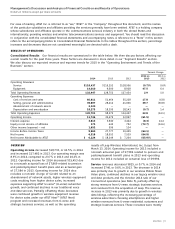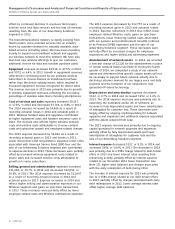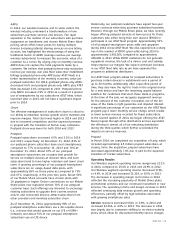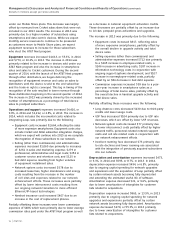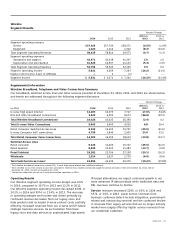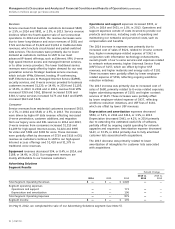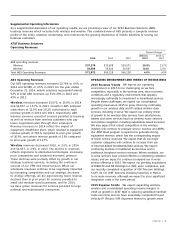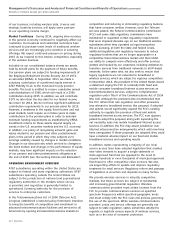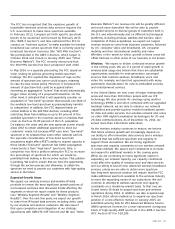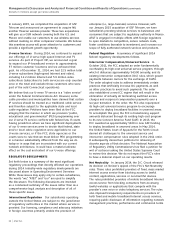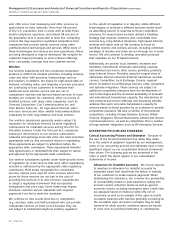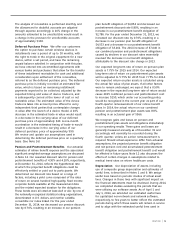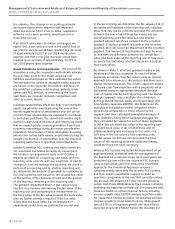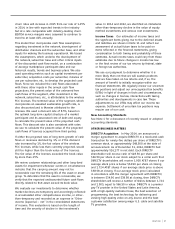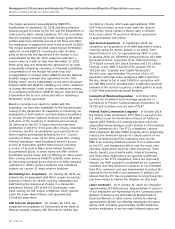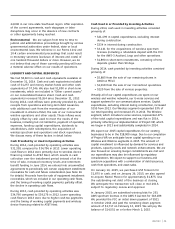AT&T Wireless 2014 Annual Report Download - page 23
Download and view the complete annual report
Please find page 23 of the 2014 AT&T Wireless annual report below. You can navigate through the pages in the report by either clicking on the pages listed below, or by using the keyword search tool below to find specific information within the annual report.
AT&T INC.
|
21
Business Matters”) our revenue mix will be greatly different
and much more diversified. We will be able to provide
integrated services to diverse groups of customers both in
the U.S. and internationally and on different technological
platforms, including wireless, satellite and wireline. Upon
completion of these acquisitions, we expect our largest
revenue stream to come from business customers, followed
by U.S. consumer video and broadband, U.S. consumer
mobility and then international mobility and video.
Whether, or the extent to which, growth in these areas will
offset declines in other areas of our business is not known.
Wireless We expect to deliver continued revenue growth
in the coming years. We are in a period of rapid growth in
wireless data usage and believe that there are substantial
opportunities available for next-generation converged
services that combine wireless, broadband, voice and
video. For example, we launched agreements with many
automobile manufacturers for vehicle-embedded security
and entertainment services.
In the United States, we now cover all major metropolitan
areas and more than 300 million people with our LTE
technology. We also provide 4G coverage using another
technology (HSPA+), and when combined with our upgraded
backhaul network, we are able to enhance our network
capabilities and provide superior mobile broadband speeds
for data and video services. Our wireless network also relies
on other GSM digital transmission technologies for 3G and
2G data communications. As of December 31, 2014, we
served more than 120 million subscribers.
As the wireless industry continues to mature, we believe
that future wireless growth will increasingly depend on
our ability to offer innovative data services and a wireless
network that has sufficient spectrum and capacity to
support these innovations. We are facing significant
spectrum and capacity constraints on our wireless network
in certain markets. We expect such constraints to increase
and expand to additional markets in the coming years.
While we are continuing to invest significant capital in
expanding our network capacity, our capacity constraints
could affect the quality of existing voice and data services
and our ability to launch new, advanced wireless broadband
services, unless we are able to obtain more spectrum.
Any long-term spectrum solution will require that the FCC
make additional spectrum available to the wireless industry
to meet the expanding needs of our subscribers. We will
continue to attempt to address spectrum and capacity
constraints on a market-by-market basis. To that end, we
closed nearly 50 deals to acquire spectrum and wireless
operations during 2014. In addition, we also acquired Leap
in March 2014, which enabled us to expand our spectrum
position in a cost-effective manner. In January 2015, we
submitted winning bids for 251 Advanced Wireless Service
(AWS) spectrum licenses for a near-nationwide contiguous
block of high-quality AWS spectrum in the AWS-3 Auction
(FCC Auction 97) for $18,189.
The FCC has recognized that the explosive growth of
bandwidth-intensive wireless data services requires the
U.S. Government to make more spectrum available.
In February 2012, Congress set forth specific spectrum
blocks to be auctioned and licensed by February 2015
(the “AWS-3 Auction”), and also authorized the FCC to
conduct an “incentive auction,” to make available for wireless
broadband use certain spectrum that is currently used by
broadcast television licensees (the “600 MHz Auction”).
We participated in the AWS-3 Auction, which began in
October 2014 and closed in January 2015 (see “Other
Business Matters”). The FCC recently announced that
the 600 MHz Auction has been postponed until 2016.
In May 2014, in a separate proceeding, the FCC issued an
order revising its policies governing mobile spectrum
holdings. The FCC rejected the imposition of caps on the
amount of spectrum any carrier could acquire, retaining
its case-by-case review policy. Moreover, it increased the
amount of spectrum that could be acquired before
exceeding an aggregation “screen” that would automatically
trigger closer scrutiny of a proposed transaction. On the
other hand, it indicated that it will separately consider an
acquisition of “low band” spectrum that exceeds one-third of
the available low band spectrum as presumptively harmful
to competition. In addition, the FCC imposed limits on
certain bidders in the 600 MHz Auction, including AT&T,
restricting them from bidding on up to 40 percent of the
available spectrum in the incentive auction in markets that
cover as much as 70-80 percent of the U.S. population.
On balance, the order and the new spectrum screen should
allow AT&T to obtain additional spectrum to meet our
customers’ needs, but because AT&T uses more “low band”
spectrum in its network than some other national carriers,
the separate consideration of low band spectrum
acquisitions might affect AT&T’s ability to expand capacity in
these bands (“low band” spectrum has better propagation
characteristics than “high band” spectrum). Also, a
competitor has filed a petition asking the FCC to increase
the percentage of spectrum for which we would be
prohibited from bidding in the incentive auction. That petition
is pending. We seek to ensure that we have the opportunity,
through the auction process and otherwise, to obtain the
spectrum we need to provide our customers with high-quality
service in the future.
Expected Growth Areas
We expect our wireless services and wireline IP-data
products to remain the most significant growth portions of
our business and have also discussed trends affecting the
segments in which we report results for these products
(see “Wireless Segment Results” and “Wireline Segment
Results”). Over the next few years, we expect our growth
to come from IP-based data services, including video, used
by our wireless and wireline customers. We also expect
that upon completion and integration of our strategic
agreements with DIRECTV, GSF Telecom and NII (see “Other


